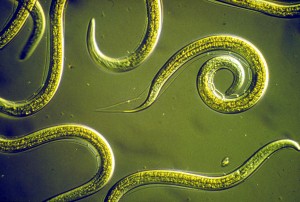
by Entomology on scienceimage.csiro.au
The vision of light is a beautiful blessing brought to us by our sight receptor cells. Since the sight of light is so great, the taste of it must be even better. Though we don’t know the taste of light, there may be a very tiny someone who does, the nematode. In the article Tasting Light: New type of photoreceptor is 50 times more efficient than the human eye, published on sciencedaily.com, it states that, at the University of Michigan, researchers have discovered a new photoreceptor amidst a bunch of taste receptor cells in nematodes and other invertebrates. This new receptor is called, LITE-1. Because of the receptor’s unusual location, it is believed that these animals have an ability to taste light. New studies have also shown that LITE-1 is no average photoreceptor.
LITR-1 was discovered in nematodes, which are eyeless roundworms only measuring about a millimeter in length. You might be thinking, “Nematodes don’t have eyes. So why would they need photoreceptors?” Shawn Xu, a senior study author who has a lab at University of Michigan Life Sciences Institute, where he is also a faculty member, demonstrated in his lab that even though nematodes are eyeless, they still move away from flashes of light. The purpose of photoreceptors is to transform light into a signal that is usable for the body. This fact leads scientists to believe that it’s possible for that the roundworm uses this photoreceptor, located among its taste receptors, so that it can convert light into something that the worm can taste in order to perceive it. Xu also says that “LITE-1 actually comes from a family of taste receptor proteins first discovered in insects.”
Though these nematodes are extremely tiny, their peculiar LITE-1 photoreceptors are nothing to be looked over. Something that makes LITE-1 strange is that it has the astounding ability to absorb UVA and UVB light. Another unusual trait of LITE-1 is that it is unlike other photoreceptor proteins. Photoreceptors consist of two parts: a base protein and a chromophore. Breaking these two sections apart does not destroy all of their ability to function. However, LITE-1, when broken apart loses its ability to absorb light entirely.
LITE-1 also has a range possible future uses, such as being applied as a sunscreen that can absorb harmful rays or being used to promote the development light sensitivity in new types of cells. The future of LITE-1 shows great promise and could open doors for the potential of other animals, besides invertebrates, to have a new and possibly delicious way of sensing light.
http://www.cell.com/cell/abstract/S0092-8674(16)31518-5


hutcherozygous
I found an article that says that a roundworm, similar to the one discussed in this post, called c. elegans, also has the ability to taste light. Unlike this post, the article says the worms are actually tasting the products of reactions of light and materials near the worm. These worms are tasting “light indirectly, by detecting the hydrogen peroxide and other reactive substances that often results when fragile molecules are damaged by light.”
More on this here:
https://www.geek.com/news/worms-detect-light-through-taste-and-it-tastes-like-bleach-1614776/